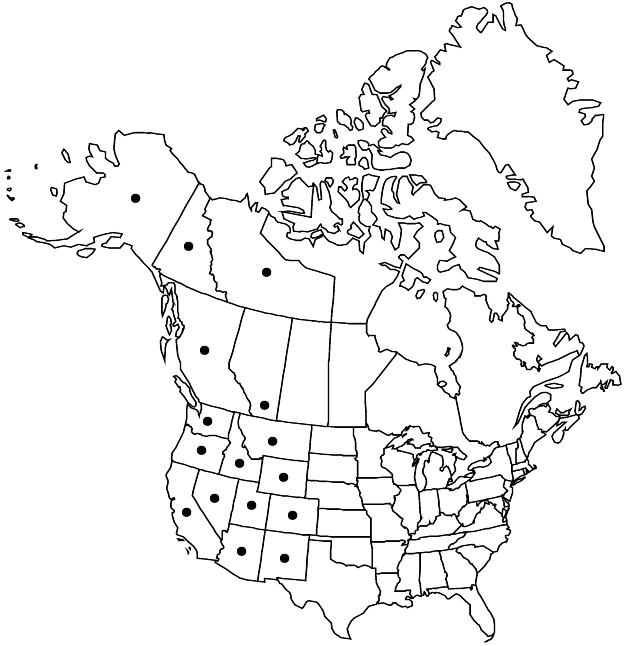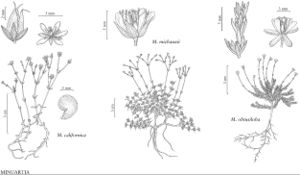Difference between revisions of "Minuartia obtusiloba"
Amer. Midl. Naturalist 7: 132. 1921.
imported>Volume Importer |
GeoffLevin (talk | contribs) m (Fixed italics in discussion) |
||
| (One intermediate revision by one other user not shown) | |||
| Line 42: | Line 42: | ||
|elevation=0-4000 m | |elevation=0-4000 m | ||
|distribution=Alta.;B.C.;N.W.T.;Yukon;Alaska;Ariz.;Calif.;Colo.;Idaho;Mont.;Nev.;N.Mex.;Oreg.;Utah;Wash.;Wyo.;Asia (Russian Far East). | |distribution=Alta.;B.C.;N.W.T.;Yukon;Alaska;Ariz.;Calif.;Colo.;Idaho;Mont.;Nev.;N.Mex.;Oreg.;Utah;Wash.;Wyo.;Asia (Russian Far East). | ||
| − | |discussion=<p><i>Minuartia obtusiloba</i>, an amphi-Beringian species, sometimes forms hybrid swarms with <i>M. arctica</i>. Specimens labeled <i>Arenaria</i> | + | |discussion=<p><i>Minuartia obtusiloba</i>, an amphi-Beringian species, sometimes forms hybrid swarms with <i>M. arctica</i>. Specimens labeled <i>Arenaria sajanensis</i> Willdenow ex Schlechtendal from western North America, sometimes referred to <i>M. biflora</i> (e.g., H. J. Scoggan 1978–1979, part 3), are likely to be <i>M. obtusiloba</i>.</p> |
|tables= | |tables= | ||
|references= | |references= | ||
| Line 65: | Line 65: | ||
|publication year=1921 | |publication year=1921 | ||
|special status=Illustrated | |special status=Illustrated | ||
| − | |source xml=https:// | + | |source xml=https://bitbucket.org/aafc-mbb/fna-data-curation/src/2e0870ddd59836b60bcf96646a41e87ea5a5943a/coarse_grained_fna_xml/V5/V5_269.xml |
|subfamily=Caryophyllaceae subfam. Alsinoideae | |subfamily=Caryophyllaceae subfam. Alsinoideae | ||
|genus=Minuartia | |genus=Minuartia | ||
Latest revision as of 15:14, 2 December 2021
Plants perennial, cespitose to mat-forming. Taproots stout, woody. Stems erect, green, 1–12 cm, trailing stems 2–20+ cm, stipitate-glandular, internodes of flowering stems 1–6 times as long as leaves. Leaves tightly overlapping (vegetative), variably spaced (cauline), usually connate proximally, with tight, scarious to herbaceous sheath 0.3–1.5 mm; blade straight to outwardly curved, green, 3-angled, 3-veined abaxially, midrib prominent, lateral veins weak in distal 1/3, needlelike to subulate, 1–8 × 0.4–1 mm, flexuous, margins not thickened, herbaceous, sometimes finely ciliate, apex green, rounded to acute, often apiculate, somewhat navicular, shiny, glabrous; axillary leaves present among vegetative leaves. Inflorescences solitary flowers, terminal, or occasionally in 2–3-flowered, open cymes; bracts subulate, herbaceous. Pedicels 0.3–1.5 cm, stipitate-glandular. Flowers: hypanthium cup-shaped; sepals prominently 3-veined proximally, narrowly ovate to oblong (herbaceous portion lanceolate to oblong), 2.9–6.5 mm, not enlarging in fruit, apex often purple, narrowly rounded, hooded; petals ovate to spatulate, 1.2–2 times as long as sepals, apex rounded, entire. Capsules narrowly ellipsoid, 3.5–6 mm, equaling sepals. Seeds reddish tan, suborbiculate with radicle prolonged into beak, somewhat compressed, 0.6–0.7 mm, obscurely sculptured (50×). 2n = 26, ca. 52, 78.
Phenology: Flowering summer.
Habitat: Dwarf willow communities, fell-fields, snow beds in subalpine and alpine areas
Elevation: 0-4000 m
Distribution

Alta., B.C., N.W.T., Yukon, Alaska, Ariz., Calif., Colo., Idaho, Mont., Nev., N.Mex., Oreg., Utah, Wash., Wyo., Asia (Russian Far East).
Discussion
Minuartia obtusiloba, an amphi-Beringian species, sometimes forms hybrid swarms with M. arctica. Specimens labeled Arenaria sajanensis Willdenow ex Schlechtendal from western North America, sometimes referred to M. biflora (e.g., H. J. Scoggan 1978–1979, part 3), are likely to be M. obtusiloba.
Selected References
None.
